The seabed grass restoration
VerifiedAdded on 2022/08/24
|7
|1592
|29
AI Summary
Contribute Materials
Your contribution can guide someone’s learning journey. Share your
documents today.
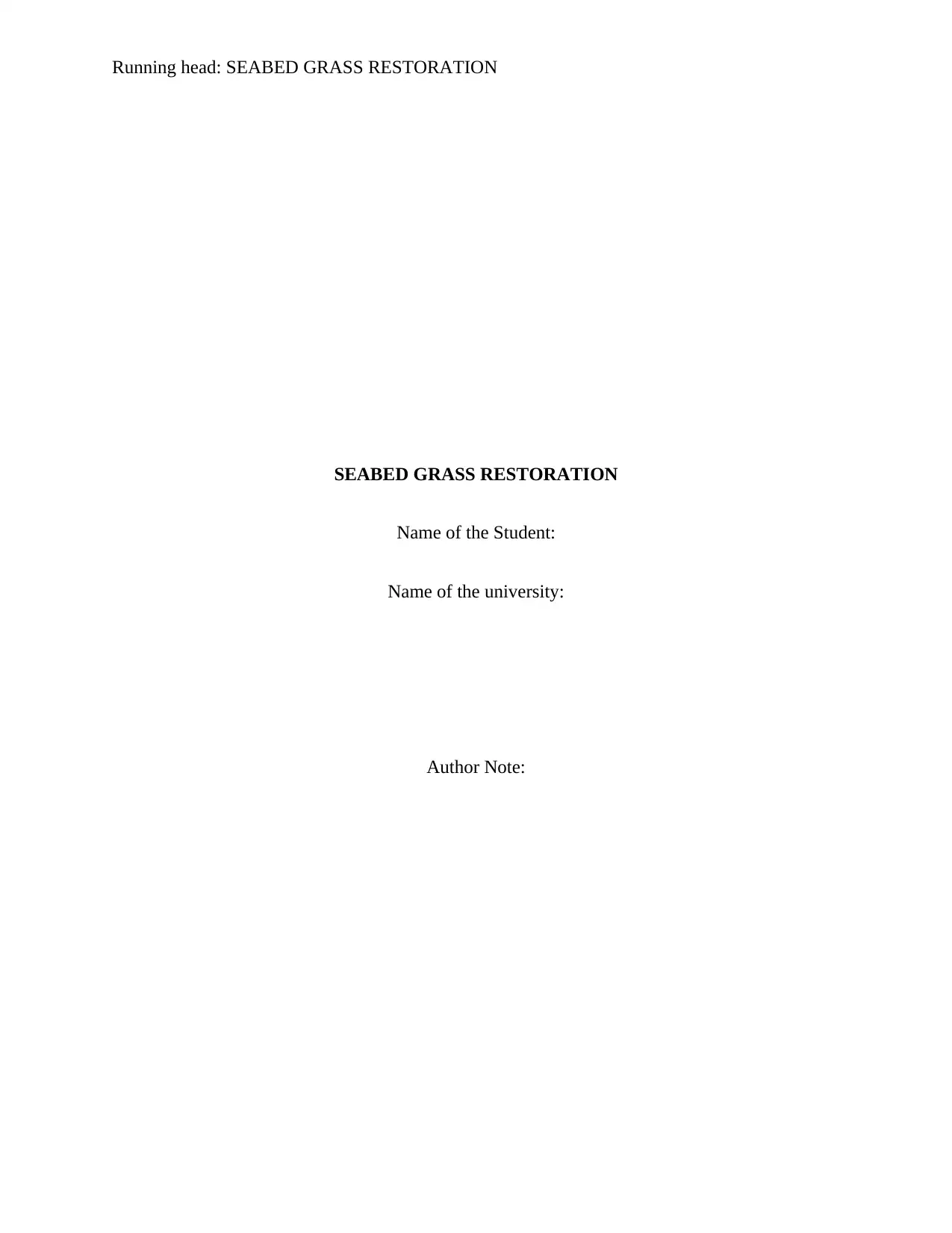
Running head: SEABED GRASS RESTORATION
SEABED GRASS RESTORATION
Name of the Student:
Name of the university:
Author Note:
SEABED GRASS RESTORATION
Name of the Student:
Name of the university:
Author Note:
Secure Best Marks with AI Grader
Need help grading? Try our AI Grader for instant feedback on your assignments.
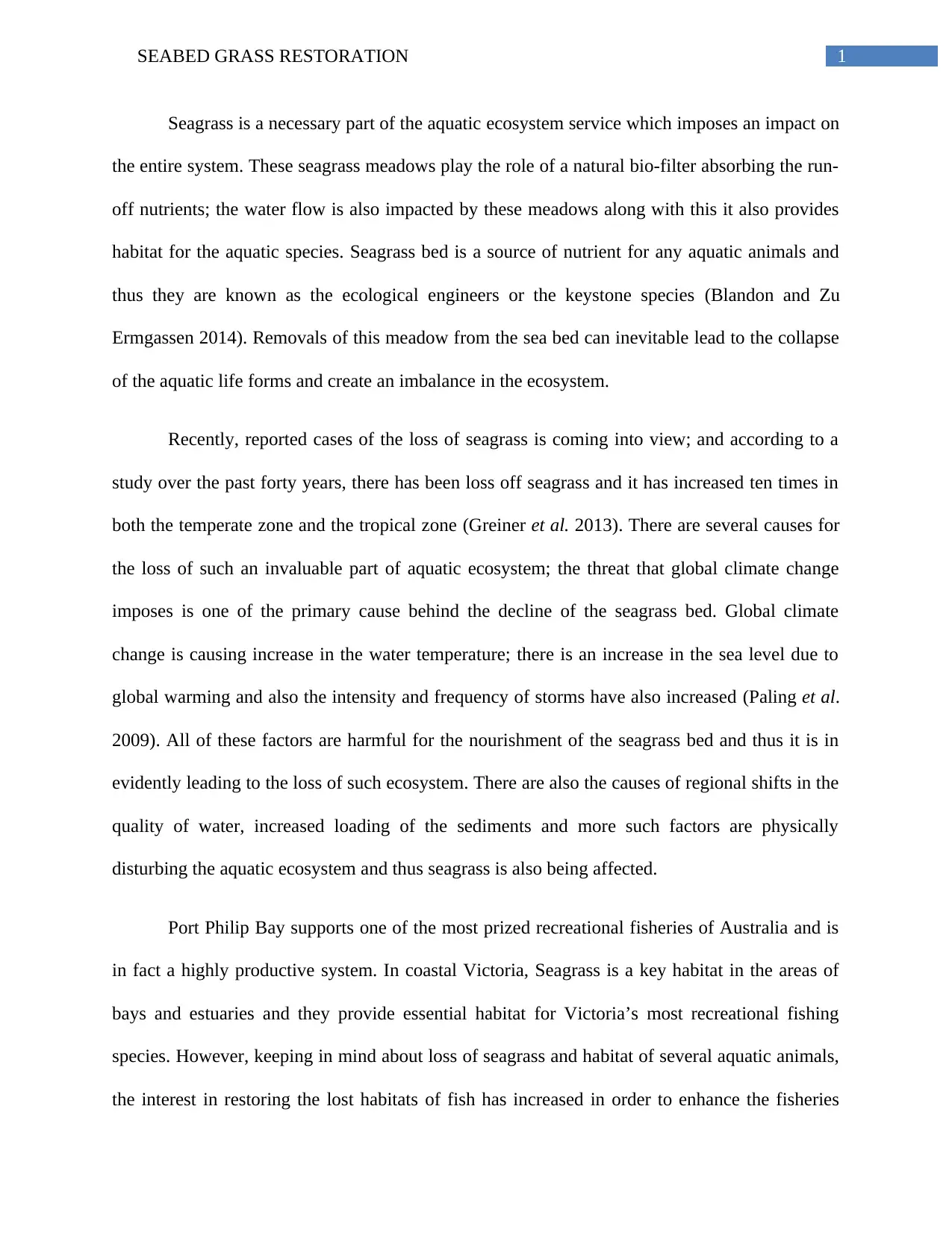
1SEABED GRASS RESTORATION
Seagrass is a necessary part of the aquatic ecosystem service which imposes an impact on
the entire system. These seagrass meadows play the role of a natural bio-filter absorbing the run-
off nutrients; the water flow is also impacted by these meadows along with this it also provides
habitat for the aquatic species. Seagrass bed is a source of nutrient for any aquatic animals and
thus they are known as the ecological engineers or the keystone species (Blandon and Zu
Ermgassen 2014). Removals of this meadow from the sea bed can inevitable lead to the collapse
of the aquatic life forms and create an imbalance in the ecosystem.
Recently, reported cases of the loss of seagrass is coming into view; and according to a
study over the past forty years, there has been loss off seagrass and it has increased ten times in
both the temperate zone and the tropical zone (Greiner et al. 2013). There are several causes for
the loss of such an invaluable part of aquatic ecosystem; the threat that global climate change
imposes is one of the primary cause behind the decline of the seagrass bed. Global climate
change is causing increase in the water temperature; there is an increase in the sea level due to
global warming and also the intensity and frequency of storms have also increased (Paling et al.
2009). All of these factors are harmful for the nourishment of the seagrass bed and thus it is in
evidently leading to the loss of such ecosystem. There are also the causes of regional shifts in the
quality of water, increased loading of the sediments and more such factors are physically
disturbing the aquatic ecosystem and thus seagrass is also being affected.
Port Philip Bay supports one of the most prized recreational fisheries of Australia and is
in fact a highly productive system. In coastal Victoria, Seagrass is a key habitat in the areas of
bays and estuaries and they provide essential habitat for Victoria’s most recreational fishing
species. However, keeping in mind about loss of seagrass and habitat of several aquatic animals,
the interest in restoring the lost habitats of fish has increased in order to enhance the fisheries
Seagrass is a necessary part of the aquatic ecosystem service which imposes an impact on
the entire system. These seagrass meadows play the role of a natural bio-filter absorbing the run-
off nutrients; the water flow is also impacted by these meadows along with this it also provides
habitat for the aquatic species. Seagrass bed is a source of nutrient for any aquatic animals and
thus they are known as the ecological engineers or the keystone species (Blandon and Zu
Ermgassen 2014). Removals of this meadow from the sea bed can inevitable lead to the collapse
of the aquatic life forms and create an imbalance in the ecosystem.
Recently, reported cases of the loss of seagrass is coming into view; and according to a
study over the past forty years, there has been loss off seagrass and it has increased ten times in
both the temperate zone and the tropical zone (Greiner et al. 2013). There are several causes for
the loss of such an invaluable part of aquatic ecosystem; the threat that global climate change
imposes is one of the primary cause behind the decline of the seagrass bed. Global climate
change is causing increase in the water temperature; there is an increase in the sea level due to
global warming and also the intensity and frequency of storms have also increased (Paling et al.
2009). All of these factors are harmful for the nourishment of the seagrass bed and thus it is in
evidently leading to the loss of such ecosystem. There are also the causes of regional shifts in the
quality of water, increased loading of the sediments and more such factors are physically
disturbing the aquatic ecosystem and thus seagrass is also being affected.
Port Philip Bay supports one of the most prized recreational fisheries of Australia and is
in fact a highly productive system. In coastal Victoria, Seagrass is a key habitat in the areas of
bays and estuaries and they provide essential habitat for Victoria’s most recreational fishing
species. However, keeping in mind about loss of seagrass and habitat of several aquatic animals,
the interest in restoring the lost habitats of fish has increased in order to enhance the fisheries
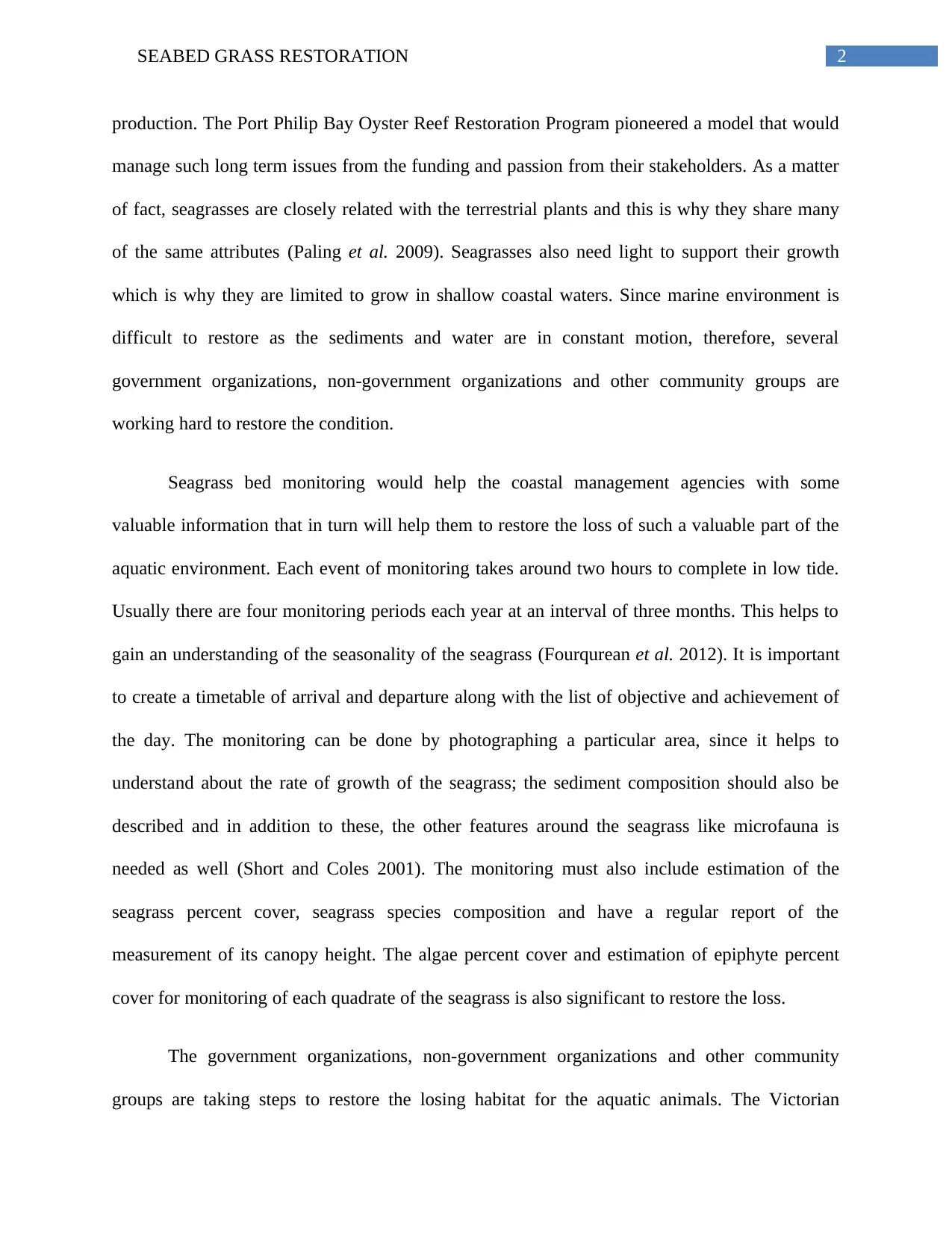
2SEABED GRASS RESTORATION
production. The Port Philip Bay Oyster Reef Restoration Program pioneered a model that would
manage such long term issues from the funding and passion from their stakeholders. As a matter
of fact, seagrasses are closely related with the terrestrial plants and this is why they share many
of the same attributes (Paling et al. 2009). Seagrasses also need light to support their growth
which is why they are limited to grow in shallow coastal waters. Since marine environment is
difficult to restore as the sediments and water are in constant motion, therefore, several
government organizations, non-government organizations and other community groups are
working hard to restore the condition.
Seagrass bed monitoring would help the coastal management agencies with some
valuable information that in turn will help them to restore the loss of such a valuable part of the
aquatic environment. Each event of monitoring takes around two hours to complete in low tide.
Usually there are four monitoring periods each year at an interval of three months. This helps to
gain an understanding of the seasonality of the seagrass (Fourqurean et al. 2012). It is important
to create a timetable of arrival and departure along with the list of objective and achievement of
the day. The monitoring can be done by photographing a particular area, since it helps to
understand about the rate of growth of the seagrass; the sediment composition should also be
described and in addition to these, the other features around the seagrass like microfauna is
needed as well (Short and Coles 2001). The monitoring must also include estimation of the
seagrass percent cover, seagrass species composition and have a regular report of the
measurement of its canopy height. The algae percent cover and estimation of epiphyte percent
cover for monitoring of each quadrate of the seagrass is also significant to restore the loss.
The government organizations, non-government organizations and other community
groups are taking steps to restore the losing habitat for the aquatic animals. The Victorian
production. The Port Philip Bay Oyster Reef Restoration Program pioneered a model that would
manage such long term issues from the funding and passion from their stakeholders. As a matter
of fact, seagrasses are closely related with the terrestrial plants and this is why they share many
of the same attributes (Paling et al. 2009). Seagrasses also need light to support their growth
which is why they are limited to grow in shallow coastal waters. Since marine environment is
difficult to restore as the sediments and water are in constant motion, therefore, several
government organizations, non-government organizations and other community groups are
working hard to restore the condition.
Seagrass bed monitoring would help the coastal management agencies with some
valuable information that in turn will help them to restore the loss of such a valuable part of the
aquatic environment. Each event of monitoring takes around two hours to complete in low tide.
Usually there are four monitoring periods each year at an interval of three months. This helps to
gain an understanding of the seasonality of the seagrass (Fourqurean et al. 2012). It is important
to create a timetable of arrival and departure along with the list of objective and achievement of
the day. The monitoring can be done by photographing a particular area, since it helps to
understand about the rate of growth of the seagrass; the sediment composition should also be
described and in addition to these, the other features around the seagrass like microfauna is
needed as well (Short and Coles 2001). The monitoring must also include estimation of the
seagrass percent cover, seagrass species composition and have a regular report of the
measurement of its canopy height. The algae percent cover and estimation of epiphyte percent
cover for monitoring of each quadrate of the seagrass is also significant to restore the loss.
The government organizations, non-government organizations and other community
groups are taking steps to restore the losing habitat for the aquatic animals. The Victorian
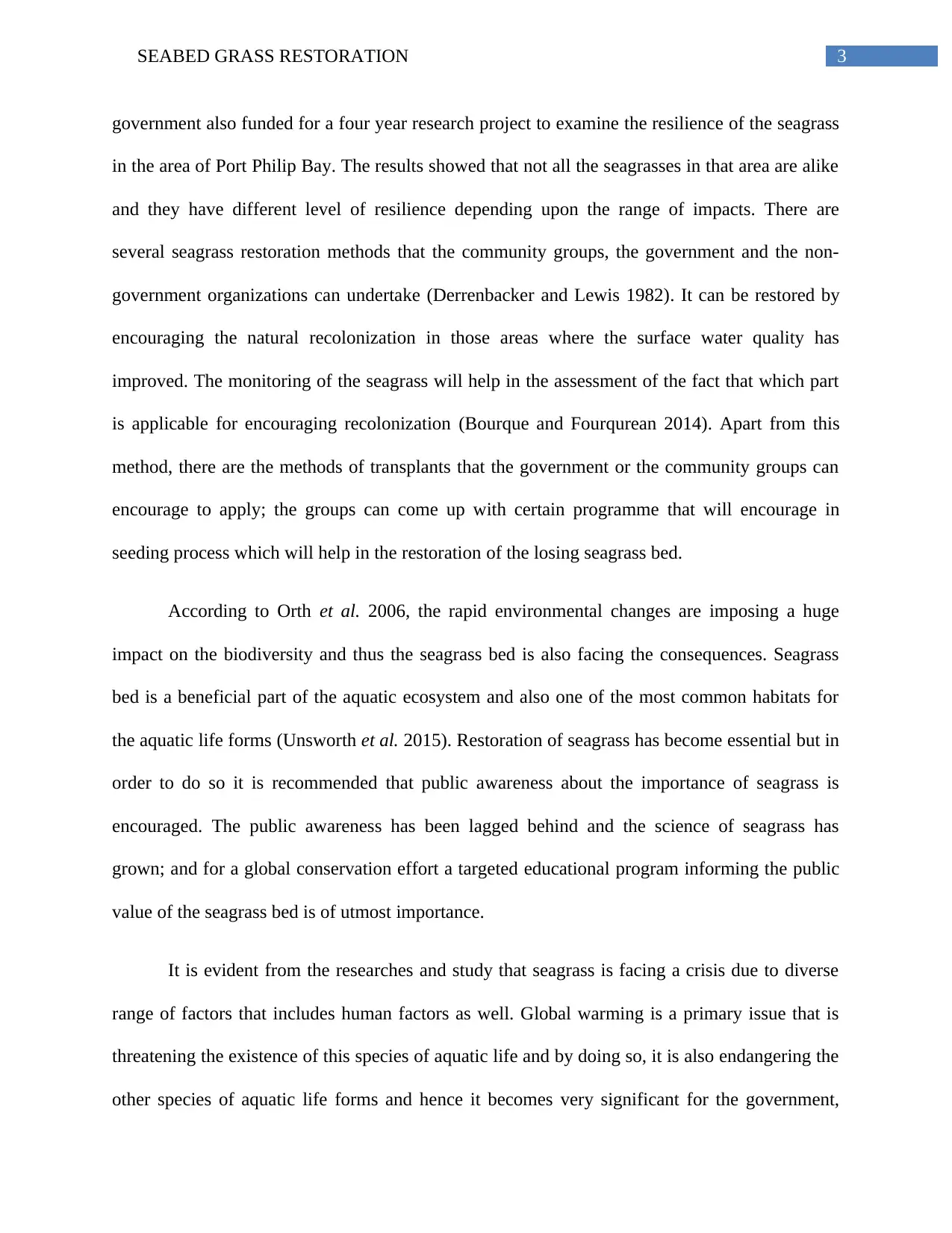
3SEABED GRASS RESTORATION
government also funded for a four year research project to examine the resilience of the seagrass
in the area of Port Philip Bay. The results showed that not all the seagrasses in that area are alike
and they have different level of resilience depending upon the range of impacts. There are
several seagrass restoration methods that the community groups, the government and the non-
government organizations can undertake (Derrenbacker and Lewis 1982). It can be restored by
encouraging the natural recolonization in those areas where the surface water quality has
improved. The monitoring of the seagrass will help in the assessment of the fact that which part
is applicable for encouraging recolonization (Bourque and Fourqurean 2014). Apart from this
method, there are the methods of transplants that the government or the community groups can
encourage to apply; the groups can come up with certain programme that will encourage in
seeding process which will help in the restoration of the losing seagrass bed.
According to Orth et al. 2006, the rapid environmental changes are imposing a huge
impact on the biodiversity and thus the seagrass bed is also facing the consequences. Seagrass
bed is a beneficial part of the aquatic ecosystem and also one of the most common habitats for
the aquatic life forms (Unsworth et al. 2015). Restoration of seagrass has become essential but in
order to do so it is recommended that public awareness about the importance of seagrass is
encouraged. The public awareness has been lagged behind and the science of seagrass has
grown; and for a global conservation effort a targeted educational program informing the public
value of the seagrass bed is of utmost importance.
It is evident from the researches and study that seagrass is facing a crisis due to diverse
range of factors that includes human factors as well. Global warming is a primary issue that is
threatening the existence of this species of aquatic life and by doing so, it is also endangering the
other species of aquatic life forms and hence it becomes very significant for the government,
government also funded for a four year research project to examine the resilience of the seagrass
in the area of Port Philip Bay. The results showed that not all the seagrasses in that area are alike
and they have different level of resilience depending upon the range of impacts. There are
several seagrass restoration methods that the community groups, the government and the non-
government organizations can undertake (Derrenbacker and Lewis 1982). It can be restored by
encouraging the natural recolonization in those areas where the surface water quality has
improved. The monitoring of the seagrass will help in the assessment of the fact that which part
is applicable for encouraging recolonization (Bourque and Fourqurean 2014). Apart from this
method, there are the methods of transplants that the government or the community groups can
encourage to apply; the groups can come up with certain programme that will encourage in
seeding process which will help in the restoration of the losing seagrass bed.
According to Orth et al. 2006, the rapid environmental changes are imposing a huge
impact on the biodiversity and thus the seagrass bed is also facing the consequences. Seagrass
bed is a beneficial part of the aquatic ecosystem and also one of the most common habitats for
the aquatic life forms (Unsworth et al. 2015). Restoration of seagrass has become essential but in
order to do so it is recommended that public awareness about the importance of seagrass is
encouraged. The public awareness has been lagged behind and the science of seagrass has
grown; and for a global conservation effort a targeted educational program informing the public
value of the seagrass bed is of utmost importance.
It is evident from the researches and study that seagrass is facing a crisis due to diverse
range of factors that includes human factors as well. Global warming is a primary issue that is
threatening the existence of this species of aquatic life and by doing so, it is also endangering the
other species of aquatic life forms and hence it becomes very significant for the government,
Secure Best Marks with AI Grader
Need help grading? Try our AI Grader for instant feedback on your assignments.

4SEABED GRASS RESTORATION
non-government organizations to put combined efforts and take measures to restore these life
forms worldwide.
non-government organizations to put combined efforts and take measures to restore these life
forms worldwide.
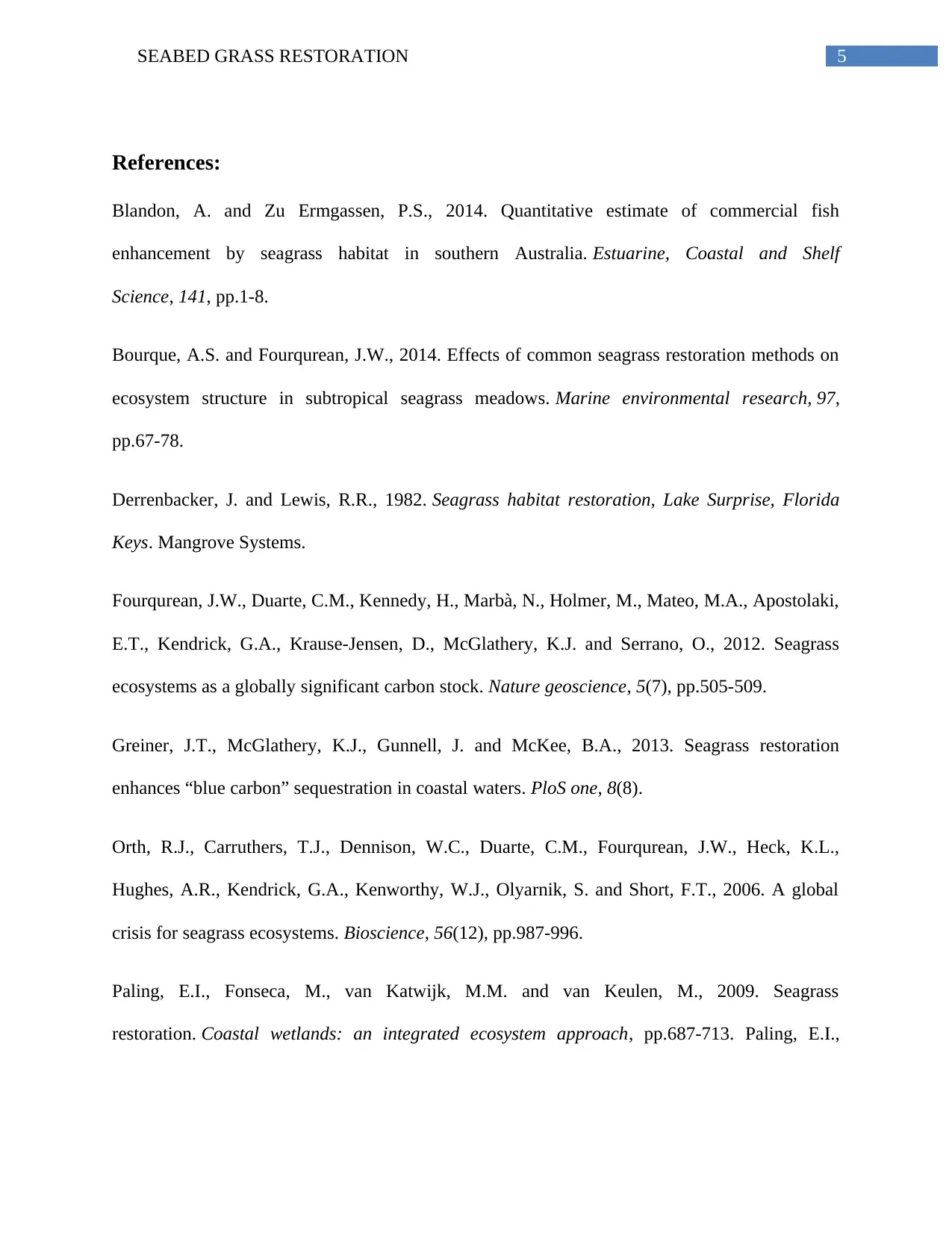
5SEABED GRASS RESTORATION
References:
Blandon, A. and Zu Ermgassen, P.S., 2014. Quantitative estimate of commercial fish
enhancement by seagrass habitat in southern Australia. Estuarine, Coastal and Shelf
Science, 141, pp.1-8.
Bourque, A.S. and Fourqurean, J.W., 2014. Effects of common seagrass restoration methods on
ecosystem structure in subtropical seagrass meadows. Marine environmental research, 97,
pp.67-78.
Derrenbacker, J. and Lewis, R.R., 1982. Seagrass habitat restoration, Lake Surprise, Florida
Keys. Mangrove Systems.
Fourqurean, J.W., Duarte, C.M., Kennedy, H., Marbà, N., Holmer, M., Mateo, M.A., Apostolaki,
E.T., Kendrick, G.A., Krause-Jensen, D., McGlathery, K.J. and Serrano, O., 2012. Seagrass
ecosystems as a globally significant carbon stock. Nature geoscience, 5(7), pp.505-509.
Greiner, J.T., McGlathery, K.J., Gunnell, J. and McKee, B.A., 2013. Seagrass restoration
enhances “blue carbon” sequestration in coastal waters. PloS one, 8(8).
Orth, R.J., Carruthers, T.J., Dennison, W.C., Duarte, C.M., Fourqurean, J.W., Heck, K.L.,
Hughes, A.R., Kendrick, G.A., Kenworthy, W.J., Olyarnik, S. and Short, F.T., 2006. A global
crisis for seagrass ecosystems. Bioscience, 56(12), pp.987-996.
Paling, E.I., Fonseca, M., van Katwijk, M.M. and van Keulen, M., 2009. Seagrass
restoration. Coastal wetlands: an integrated ecosystem approach, pp.687-713. Paling, E.I.,
References:
Blandon, A. and Zu Ermgassen, P.S., 2014. Quantitative estimate of commercial fish
enhancement by seagrass habitat in southern Australia. Estuarine, Coastal and Shelf
Science, 141, pp.1-8.
Bourque, A.S. and Fourqurean, J.W., 2014. Effects of common seagrass restoration methods on
ecosystem structure in subtropical seagrass meadows. Marine environmental research, 97,
pp.67-78.
Derrenbacker, J. and Lewis, R.R., 1982. Seagrass habitat restoration, Lake Surprise, Florida
Keys. Mangrove Systems.
Fourqurean, J.W., Duarte, C.M., Kennedy, H., Marbà, N., Holmer, M., Mateo, M.A., Apostolaki,
E.T., Kendrick, G.A., Krause-Jensen, D., McGlathery, K.J. and Serrano, O., 2012. Seagrass
ecosystems as a globally significant carbon stock. Nature geoscience, 5(7), pp.505-509.
Greiner, J.T., McGlathery, K.J., Gunnell, J. and McKee, B.A., 2013. Seagrass restoration
enhances “blue carbon” sequestration in coastal waters. PloS one, 8(8).
Orth, R.J., Carruthers, T.J., Dennison, W.C., Duarte, C.M., Fourqurean, J.W., Heck, K.L.,
Hughes, A.R., Kendrick, G.A., Kenworthy, W.J., Olyarnik, S. and Short, F.T., 2006. A global
crisis for seagrass ecosystems. Bioscience, 56(12), pp.987-996.
Paling, E.I., Fonseca, M., van Katwijk, M.M. and van Keulen, M., 2009. Seagrass
restoration. Coastal wetlands: an integrated ecosystem approach, pp.687-713. Paling, E.I.,
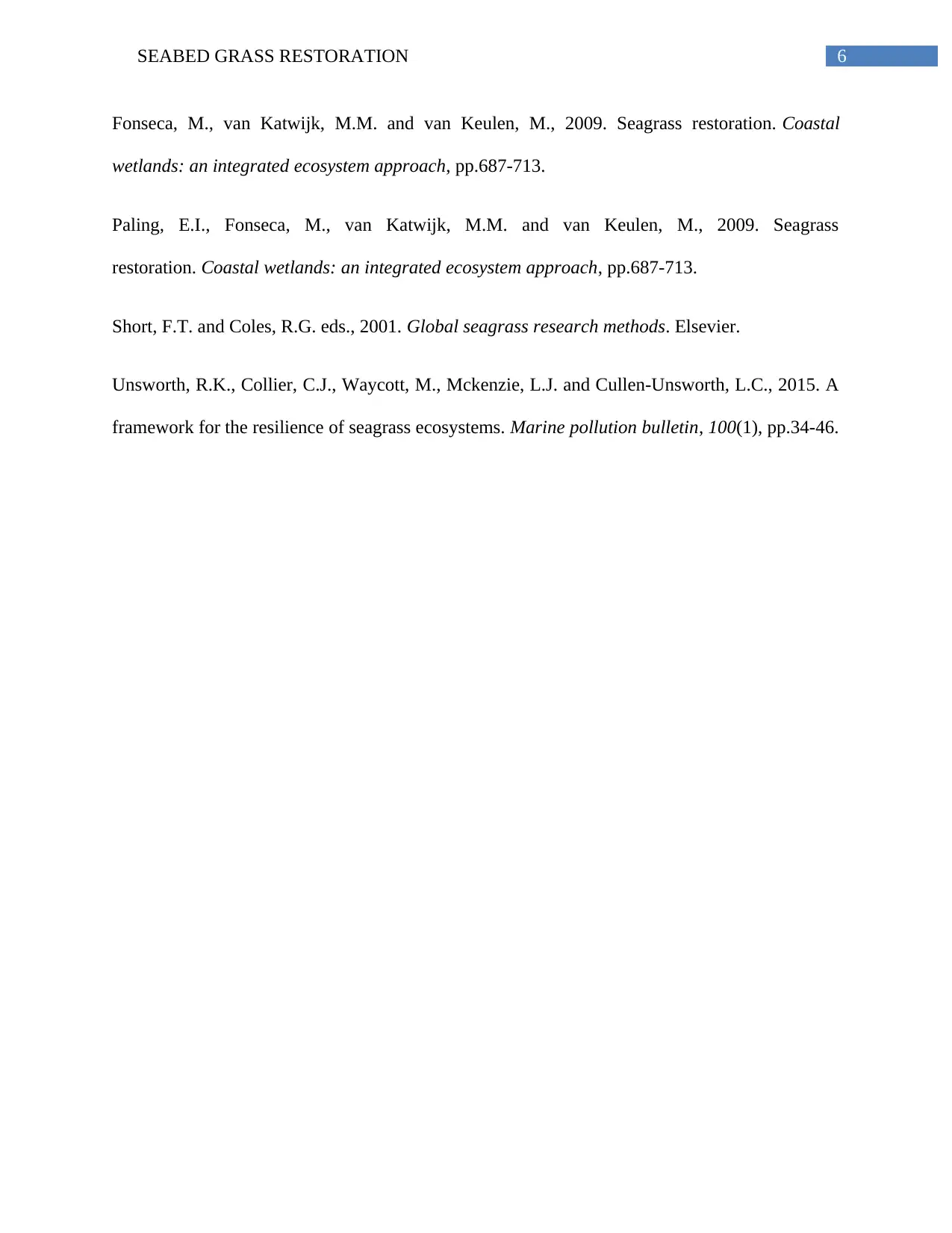
6SEABED GRASS RESTORATION
Fonseca, M., van Katwijk, M.M. and van Keulen, M., 2009. Seagrass restoration. Coastal
wetlands: an integrated ecosystem approach, pp.687-713.
Paling, E.I., Fonseca, M., van Katwijk, M.M. and van Keulen, M., 2009. Seagrass
restoration. Coastal wetlands: an integrated ecosystem approach, pp.687-713.
Short, F.T. and Coles, R.G. eds., 2001. Global seagrass research methods. Elsevier.
Unsworth, R.K., Collier, C.J., Waycott, M., Mckenzie, L.J. and Cullen-Unsworth, L.C., 2015. A
framework for the resilience of seagrass ecosystems. Marine pollution bulletin, 100(1), pp.34-46.
Fonseca, M., van Katwijk, M.M. and van Keulen, M., 2009. Seagrass restoration. Coastal
wetlands: an integrated ecosystem approach, pp.687-713.
Paling, E.I., Fonseca, M., van Katwijk, M.M. and van Keulen, M., 2009. Seagrass
restoration. Coastal wetlands: an integrated ecosystem approach, pp.687-713.
Short, F.T. and Coles, R.G. eds., 2001. Global seagrass research methods. Elsevier.
Unsworth, R.K., Collier, C.J., Waycott, M., Mckenzie, L.J. and Cullen-Unsworth, L.C., 2015. A
framework for the resilience of seagrass ecosystems. Marine pollution bulletin, 100(1), pp.34-46.
1 out of 7
Your All-in-One AI-Powered Toolkit for Academic Success.
+13062052269
info@desklib.com
Available 24*7 on WhatsApp / Email
![[object Object]](/_next/static/media/star-bottom.7253800d.svg)
Unlock your academic potential
© 2024 | Zucol Services PVT LTD | All rights reserved.
